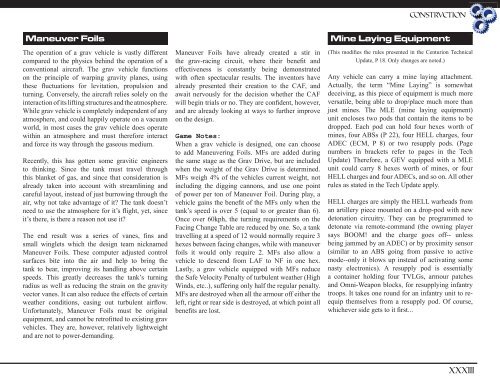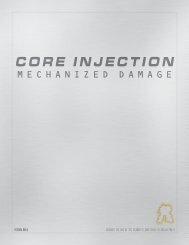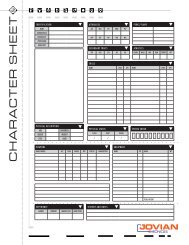renegadelegionneveren dingoffensive - Catsden.net
renegadelegionneveren dingoffensive - Catsden.net
renegadelegionneveren dingoffensive - Catsden.net
You also want an ePaper? Increase the reach of your titles
YUMPU automatically turns print PDFs into web optimized ePapers that Google loves.
CONSTRVCTION<br />
Maneuver Foils<br />
The operation of a grav vehicle is vastly different<br />
compared to the physics behind the operation of a<br />
conventional aircraft. The grav vehicle functions<br />
on the principle of warping gravity planes, using<br />
these fluctuations for levitation, propulsion and<br />
turning. Conversely, the aircraft relies solely on the<br />
interaction of its lifting structures and the atmosphere.<br />
While grav vehicle is completely independent of any<br />
atmosphere, and could happily operate on a vacuum<br />
world, in most cases the grav vehicle does operate<br />
within an atmosphere and must therefore interact<br />
and force its way through the gaseous medium.<br />
Recently, this has gotten some gravitic engineers<br />
to thinking. Since the tank must travel through<br />
this blanket of gas, and since that consideration is<br />
already taken into account with streamlining and<br />
careful layout, instead of just burrowing through the<br />
air, why not take advantage of it? The tank doesn’t<br />
need to use the atmosphere for it’s flight, yet, since<br />
it’s there, is there a reason not use it?<br />
The end result was a series of vanes, fins and<br />
small winglets which the design team nicknamed<br />
Maneuver Foils. These computer adjusted control<br />
surfaces bite into the air and help to bring the<br />
tank to bear, improving its handling above certain<br />
speeds. This greatly decreases the tank’s turning<br />
radius as well as reducing the strain on the gravity<br />
vector vanes. It can also reduce the effects of certain<br />
weather conditions, easing out turbulent airflow.<br />
Unfortunately, Maneuver Foils must be original<br />
equipment, and cannot be retrofitted to existing grav<br />
vehicles. They are, however, relatively lightweight<br />
and are not to power-demanding.<br />
Maneuver Foils have already created a stir in<br />
the grav-racing circuit, where their benefit and<br />
effectiveness is constantly being demonstrated<br />
with often spectacular results. The inventors have<br />
already presented their creation to the CAF, and<br />
await nervously for the decision whether the CAF<br />
will begin trials or no. They are confident, however,<br />
and are already looking at ways to further improve<br />
on the design.<br />
Game Notes:<br />
When a grav vehicle is designed, one can choose<br />
to add Maneuvering Foils. MFs are added during<br />
the same stage as the Grav Drive, but are included<br />
when the weight of the Grav Drive is determined.<br />
MFs weigh 4% of the vehicles current weight, not<br />
including the digging cannons, and use one point<br />
of power per ton of Maneuver Foil. During play, a<br />
vehicle gains the benefit of the MFs only when the<br />
tank’s speed is over 5 (equal to or greater than 6).<br />
Once over 60kph, the turning requirements on the<br />
Facing Change Table are reduced by one. So, a tank<br />
travelling at a speed of 12 would normally require 3<br />
hexes between facing changes, while with maneuver<br />
foils it would only require 2. MFs also allow a<br />
vehicle to descend from LAF to NF in one hex.<br />
Lastly, a grav vehicle equipped with MFs reduce<br />
the Safe Velocity Penalty of turbulent weather (High<br />
Winds, etc..), suffering only half the regular penalty.<br />
MFs are destroyed when all the armour off either the<br />
left, right or rear side is destroyed, at which point all<br />
benefits are lost.<br />
Mine Laying Equipment<br />
(This modifies the rules presented in the Centurion Technical<br />
Update, P 18. Only changes are noted.)<br />
Any vehicle can carry a mine laying attachment.<br />
Actually, the term “Mine Laying” is somewhat<br />
deceiving, as this piece of equipment is much more<br />
versatile, being able to drop/place much more than<br />
just mines. The MLE (mine laying equipment)<br />
unit encloses two pods that contain the items to be<br />
dropped. Each pod can hold four hexes worth of<br />
mines, four ABSs (P 22), four HELL charges, four<br />
ADEC (ECM, P 8) or two resupply pods. (Page<br />
numbers in brackets refer to pages in the Tech<br />
Update) Therefore, a GEV equipped with a MLE<br />
unit could carry 8 hexes worth of mines, or four<br />
HELL charges and four ADECs, and so on. All other<br />
rules as stated in the Tech Update apply.<br />
HELL charges are simply the HELL warheads from<br />
an artillery piece mounted on a drop-pod with new<br />
detonation circuitry. They can be programmed to<br />
detonate via remote-command (the owning player<br />
says BOOM! and the charge goes off-- unless<br />
being jammed by an ADEC) or by proximity sensor<br />
(similar to an ABS going from passive to active<br />
mode--only it blows up instead of activating some<br />
nasty electronics). A resupply pod is essentially<br />
a container holding four TVLGs, armour patches<br />
and Omni-Weapon blocks, for resupplying infantry<br />
troops. It takes one round for an infantry unit to reequip<br />
themselves from a resupply pod. Of course,<br />
whichever side gets to it first...<br />
XXXIII





